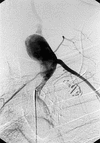Large extracranial vertebral aneurysm with absent contralateral vertebral artery
- PMID: 12809256
- PMCID: PMC161900
Large extracranial vertebral aneurysm with absent contralateral vertebral artery
Abstract
The extracranial segment of the vertebral artery is well protected, and the rate of occurrence of extracranial vertebral aneurysms is very low. We describe the case of a 40-year-old woman who presented with a large aneurysm of the left vertebral artery in the angiographic absence of a right vertebral artery. Her medical history included a motorcycle accident at the age of 20, at which time a neck sprain had been diagnosed. Computed tomography of the chest and neck revealed a 6- x 4-cm aneurysm with mural thrombus in the left thoracic outlet and in the first portion of the left vertebral artery before the entrance of the transverse foramen of the 6th cervical vertebra. Angiography of the arch vessels confirmed both the presence of an aneurysm of the left vertebral artery and the absence of a right vertebral artery. Due to the lack of contralateral vertebral flow, we planned to perform a graft interposition under deep hypothermic circulatory arrest, for cerebral protection. Unfortunately, the patient refused the operation and was lost to follow-up. To our knowledge, there has been no previous report of an extracranial vertebral artery aneurysm in the absence of a contralateral vertebral artery. We believe that deep hypothermic circulatory arrest with graft interposition is the best treatment strategy, although we did not, in this case, have opportunity to treat the patient.
Figures




Similar articles
-
Successful endovascular treatment for thrombosed giant aneurysm of the V1 segment of the vertebral artery: A case report.Interv Neuroradiol. 2017 Dec;23(6):628-631. doi: 10.1177/1591019917722515. Epub 2017 Jul 27. Interv Neuroradiol. 2017. PMID: 28750562 Free PMC article.
-
Dual origin extracranial vertebral artery: case report and embryology.J Neuroimaging. 2008 Apr;18(2):173-6. doi: 10.1111/j.1552-6569.2007.00182.x. Epub 2007 Nov 6. J Neuroimaging. 2008. PMID: 18302642
-
[Flow diversion by double-overlapping-stent for fusiform vertebral artery aneurysm: a case report].No Shinkei Geka. 2011 Jan;39(1):59-63. No Shinkei Geka. 2011. PMID: 21270480 Japanese.
-
Neurofibromatosis Type 1-Associated Extracranial Vertebral Artery Aneurysm Complicated by Vertebral Arteriovenous Fistula After Rupture: Case Report and Literature Review.World Neurosurg. 2016 Dec;96:609.e13-609.e18. doi: 10.1016/j.wneu.2016.09.036. Epub 2016 Sep 16. World Neurosurg. 2016. PMID: 27647034 Review.
-
Atraumatic extracranial vertebral artery aneurysm: case report and review of the literature.J Vasc Surg. 1986 Sep;4(3):288-93. J Vasc Surg. 1986. PMID: 3528535 Review.
Cited by
-
Unilateral Aplasia versus Bilateral Aplasia of the Vertebral Artery: A Review of Associated Abnormalities.Biomed Res Int. 2017;2017:7238672. doi: 10.1155/2017/7238672. Epub 2017 Aug 28. Biomed Res Int. 2017. PMID: 28932744 Free PMC article. Review.
-
Pseudo subclavian steal syndrome: Case report.Int J Surg Case Rep. 2015;16:177-80. doi: 10.1016/j.ijscr.2015.09.029. Epub 2015 Sep 28. Int J Surg Case Rep. 2015. PMID: 26479783 Free PMC article.
-
Extracranial Vertebral Artery Aneurysm: An Unpleasant Consequence of Neck Massage.J Neurosci Rural Pract. 2018 Oct-Dec;9(4):655-657. doi: 10.4103/jnrp.jnrp_118_18. J Neurosci Rural Pract. 2018. PMID: 30271074 Free PMC article. No abstract available.
-
Ultrasonic analysis of the anatomical relationships between vertebral arteries and internal jugular veins in children.Paediatr Anaesth. 2012 Sep;22(9):854-8. doi: 10.1111/j.1460-9592.2012.03816.x. Epub 2012 Feb 20. Paediatr Anaesth. 2012. PMID: 22340889 Free PMC article.
-
Predictive value of vertebral artery extracranial color-coded duplex sonography for ischemic stroke-related vertigo.Kaohsiung J Med Sci. 2013 Dec;29(12):667-72. doi: 10.1016/j.kjms.2013.01.015. Epub 2013 Aug 30. Kaohsiung J Med Sci. 2013. PMID: 24296055 Free PMC article.
References
-
- Amaral JF, Grigoriev VE, Dorfman GS, Carney WI Jr. Vertebral artery pseudoaneurysm. A rare complication of subclavian artery catheterization. Arch Surg 1990;125:546–7. - PubMed
-
- Anand VK, Raila FA, McAuley JR, Reed JM. Large pseudoaneurysm of the extracranial vertebral artery. Otolaryngol Head Neck Surg 1993;109:1057–60. - PubMed
-
- Sumimura J, Nakao K, Miyata M, Kamiike W, Yokota H, Kawashima Y. Vertebral aneurysm of the neck. J Cardiovasc Surg (Torino) 1988;29:63–5. - PubMed
-
- Yasui T, Komiyama M, Nishikawa M, Nakajima H, Kobayashi Y, Inoue T. Fusiform vertebral artery aneurysms as a cause of dissecting aneurysms. Report of two autopsy cases and a review of the literature. J Neurosurg 1999;91:139–44. - PubMed
-
- Reid JD, Weigelt JA. Forty-three cases of vertebral artery trauma. J Trauma 1988;28:1007–12. - PubMed
Publication types
MeSH terms
LinkOut - more resources
Full Text Sources
Medical
